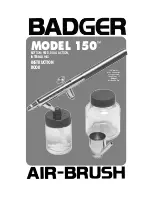
7
TECHNIQUES TO USE
Masking or frisket is used mostly to create a sharp edge or when more than one color is applied. A new
frisket is cut for each color and covers any area that should not
be sprayed. Badger’s Foto/Frisket
™
Film is specially formulated
for use on all surfaces commonly used for airbrushing.
A flat surface mask can be cut from Foto/Frisket
™
Film. For a
sharp edge, hold the mask flat in position. For a softer edge,
elevate the mask slightly by resting on a ruler or other flat object.
For contour masking (models, ceramics, etc.) liquid frisket is
recommended.
STENCILS/TEMPLATES
Stencils/templates are used when a design needs to be
duplicated, as in posters and decorating. Cut from stiff paper,
FOTO/FRISKET™ FILM or NO-TACK Stencil Film, hold the
stencil firmly in position and spray starting with the edges
and work inward. A reverse (negative) stencil can also be
used, spray along the stencil edge.
EXERCISE FIVE/THREE DIMENSIONAL EFFECTS USING MASKS OR FRISKET
Rendering these basic forms will provide instruction and sequence in shading and tone gradiation created
with airbrush for three dimensional effect and realism. In airbrushing these shapes, it is a general rule to
have the light source coming from the upper left hand corner at about a 45 degree angle.
SPHERE Place a frisket on the board making sure the remaining portion of the
board is not exposed to airbrushing overspray. Use a compass knife and cut your
circle and remove. Gradually airbrush lightly around the entire edge of the circle in
a curved, rocking, back and forth motion. Next, start from the bottom right hand
portion of the circle and airbrush upwards towards the center not quite reaching
the center. Allow a highlighted circular portion of the sphere near the upper left
hand portion. Continue until the sphere takes on a three dimensional appearance.
CUBE Make a line drawing lightly about twice the size of the above illustration. Cut
a frisket for the outline and dividing lines of the sepa-
rate sides. At this time remove the frisket from the side farthest from the light
source (lower right). Gradually airbrush a tone from the upper left corner to the
lower right hand corner. Repeat the gradual dark tone as
necessary, then remask the finished side and start the other
sides until the desired effect is achieved.
CYLINDER Note how the light varies on the cylinder and
makes the top flat surface different from the curved area.
The frisket is cut along the curved line and while the top is
masked, the side is sprayed. Then the side is masked and the top is sprayed. Only
practice will enable you to know how dark to paint one side of the subject while the
other is masked.
TROUBLESHOOTING YOUR AIRBRUSH
1) Grainy spray. Caused by paint being too thick. Add thinner sparingly to the mixture and check the needle and regu-
lator tip for dried paint. Also check the air supply to make sure airbrush is being operated at the proper pressure.
2) Buckling paper. Paint may be too thin or you may be applying paint in too heavy a coat.
3) Paint blobs at the ends of the stroke. You are spraying paint before moving your hand and stopping the move-
ments before shutting off the paint flow.
4) Flared ends. Caused by turning the wrist while airbrushing. The whole forearm should move evenly across the
paper.
5) Centipedes. Caused by spraying too much paint too close to the paper. If a fine line is desired, lightly pull back on
the front trigger.
6) Splattering. Caused by permitting the needle to snap back into tip. Always release the trigger gently. Check for
dried paint on needle or tip. Also may be caused by triggering, see page 3 for proper triggering.
7) Curved stroke. Caused by arcing arm too close to the paper. Arm should always be parallel to the work, unless this
POSITIVE
REVERSE (negative)


























